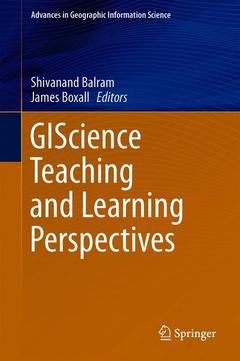Description
GIScience Teaching and Learning Perspectives, 1st ed. 2019
Advances in Geographic Information Science Series
Coordinators: Balram Shivanand, Boxall James
Language: English
Subjects for GIScience Teaching and Learning Perspectives:
200 p. · 15.5x23.5 cm · Hardback
Description
/li>Contents
/li>Biography
/li>Comment
/li>
Chapter1: Teaching and learning pedagogies in higher education geographic information science.- Chapter2: The evolution and definition of geospatial literacy.- Chapter3: Enabling scientific research skills in undergraduate students during a spatial modeling course.- Chapter4: The AMETHYST program: The NSERC create experience.- Chapter5: "The map is not the territory": Adding value to technical GIS education.- Chapter6: Using an online format to teach graduate-level remote sensing basics.- Chapter7: WebGIS in development: From research and teaching perspectives.- Chapter8: Neogeography: Rethinking participatory mapping and place-based learning in the geoweb age.- Chapter9: Navigating employment prospects for new graduates in the geospatial sciences.- Chapter10: Epilogue: Future of convergence and crisis
University teaching and service have always been tightly interconnected aspects for Shivanand Balram. Since his undergraduate studies he has been continuously active in all aspects of university teaching and service in various capacities. He has an undergraduate degree in Physics (solar energy applications), a Masters degree in GIS and Remote Sensing (medical geography), and a PhD degree in Geography (GIS and Environmental Modelling) together with more than twenty years of university teaching experience. In chronological order, he was: Instructor for High School Physics Students, University Lecturer in Physics, GIS Consultant for a US$ 3M training program for government agencies, Urban GIS consultant for a US$10M Inter-American Development Bank urban renewal program, Online course instructor, MOOC course instructor, and currently serves as a Senior Lecturer of Spatial and Geographic Information Science. Through a number of grants from internal and external sources for the last 5 years, he has completed three projects dealing with blended learning, learning outcomes, and video learning objects within a Scholarship of Teaching and Learning (SoTL) investigation framework. He has contributed to the profession through peer-reviewed publications, manuscript reviews, conference organization, specialized committees of professional organizations, and graduate student supervisory committees.
James Boxall is first and foremost an educator. He teaches geography and GIS at Dalhousie University where holds appointments in Marine Affairs, Planning, Earth Sciences and Information management. His current position is as The Geographer in the GIS Centre at Dalhousie. He was on the National Science Foundation Review Panel of the Alexandria Digital Geolibrary project, a past-president of the Canadian Cartographic Association, the Association of Canadian Map Libraries and Archives, and the Geomatics Association of Nova Scotia. He is a Governor and Fellow of t
Links educational theories and the practice of GIScience in higher education contexts
Provides resources and strategies for effective teaching, and discusses current trends and future educational needs in GIScience
Offers a comprehensive exploration of GIScience education for educators, instructors, and learners




